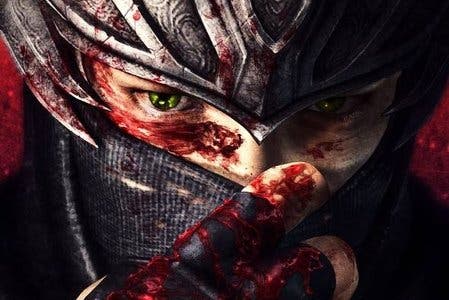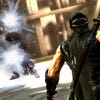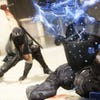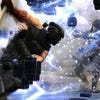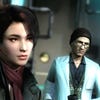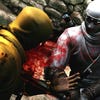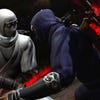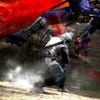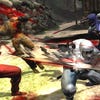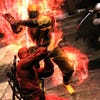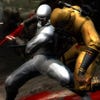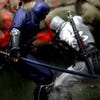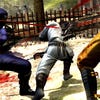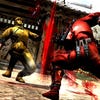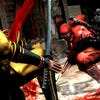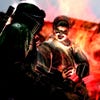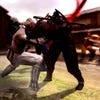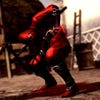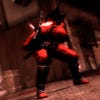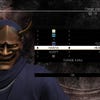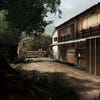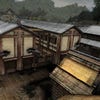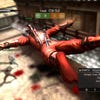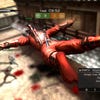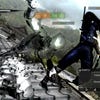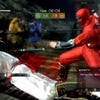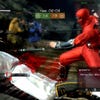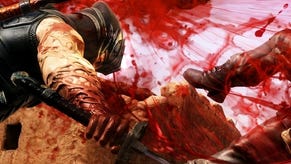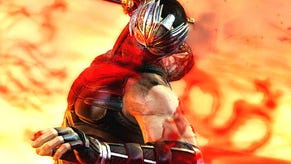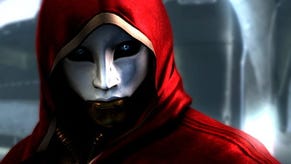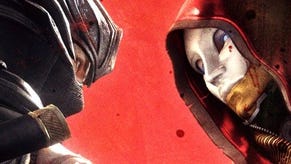Ninja Gaiden 3 Review
In an English country gaiden.
The voice actor is almost certainly not English, his cockney twang too off-kilter and overstated. Regardless, he takes to the role with enthusiasm, backing away from ninja Ryu Hayabusa, gun dropped, mouth wagging with laboured pleas for mercy. The last man standing from a platoon of soldiers now twitching on a London pavement wet with rain and blood, he hopes to appeal to Hayabusa's humanity with talk of a daughter back home and the fact he only took the job for the money.
His back thuds against a truck. There's nowhere left to retreat and nothing left to say. A giant button icon flashes up on screen, indicating that control has switched from the cut-scene director back to your hands. The game side-glances at you as if to say: 'What you gonna do?'
It's an illusion of choice, of course. There is no decision to be made, no capacity for mercy. You must press X to eviscerate. There is no other way. Place your controller on the floor just to see how long these two men will stand in quivering silence while the rain pitter-patters around their puppet bodies, and you'll be waiting forever. All that happens is that the button pulses ever more feverishly on screen, as if to say: 'Finish it, coward!'
All that is left to be done is finish it then, not through choice but through a lack of choice, despite the pretence that there's another outcome. It's irritating not because the soldier gurgles his way through the death scene like Dick Van Dyke spearing himself on a Chim Chim Cher-ee broom handle, but because if a game is going to force you to play like an a**hole, it should have a stronger reason for doing so than 'You're a ninja, duh.' Ninja Gaiden 3 has none.
For some, moral choices and narrative cause-and-effect will be of no interest, these players instead coming to Ninja Gaiden 3 to have their reflexes tested, to express themselves through the cut-throat ballet of katana combat. But this illusion of choice is weaved into Ninja Gaiden 3's DNA. With just two core attack buttons and a handful of ways to string these attacks together, your interactive options are limited and repetitive. Even aside from comparisons to the classic combat of the previous few games in the series, the lack of depth or nuance to this game's base interactions make this a dull, if spectacular, affair.
The difficulty of Tomonobu Itagaki's Ninja Gaiden games is gone, replaced by button-mash heroics that fill the screen with slick, camera-wheeling animations which that excite while also deceiving. All but the toughest boss battles can be hammered through and there are no new abilities to be won or bought, no new techniques to learn and master. The orb currency used to upgrade Hayabusa's equipment in previous games is gone, and the lack of any overarching experience or development systems places the full weight of engagement on the moment-by-moment play.
But this play is light and one-note. The option to hurl shuriken to segue between katana attacks has the sniff of Devil May Cry's combo-creation about it, but there is no combo counter to be seen on screen - ensuring that your only capacity to dazzle onlookers is through canned, animated spectacle rather than skill.
Two special attacks have survived in the game: one ninpo that can be triggered when you fill the relevant meter, summoning a Final Fantasy-style dragon eidolon that engulfs enemies in flames; the other a glowing red aura effect that takes over Hayabusa's arm during battle, eventually triggering a snap-attack series of animations where enemies can be dismembered by holding down the relevant button.
Ninja Gaiden 3's monotonous rhythm is upset with a series of Ninja Blade-style quick time events, from a basic wall-climbing sequence in which you alternate button presses to pull yourself upwards using kunai with un-ninja-like awkwardness, to actions that require you hammer a button to build tension or bring release during a particularly climactic battle. There's the odd stealth section, asking you to manoeuvre behind enemies for silent takedowns, and the addition of a bow and arrow that locks on to targets offers some sport as you try to take down motorcycle bandits. But there is very little variation in the types of enemies you attack, and series staples like wall-running lack any of the physicality of comparable sections in Ninja Gaiden 2.
'Is Hayabusa a hero or a murderer?' the game ponders for a few seconds every 20 minutes or so - before settling back into the simpler question of whether you are going to kill this enemy with the X or Square button.
Team Ninja's focus on story is misguided. Hayabusa's infected arm is a manifestation of the man's sins, each kill adding to its grotesqueness. But the dialogue writers are unable to meet their intended themes of repentance and redemption in interesting or affecting ways, while the game designers on the team throw incongruous dinosaurs and quadruped robots at the player with giddy abandon.
Writer Masato Kato may have worked on the NES original, but his attempts to explore the dark hero in 2012 feel outdated, simplistic and uninteresting. 'Is Hayabusa a hero or a murderer?' the game ponders for a few seconds every 20 minutes or so - before settling back into the simpler question of whether you are going to kill this enemy with the X or Square button. It's the only question that the game seems capable of resolving.Better is the multiplayer, which introduces some of the meta-game systems lacking in the single-player portion of the game, rewarding you with customisation options and upgrades. Deathmatch mode is a taut, exciting affair where moving slowly through the environments gifts invisibility and, played with eight ninjas, it can be fun. But there's little more than a couple of hours of interest here; the framework's unable to sustain longer engagement.
As a mindless action game, Ninja Gaiden 3 offers mild entertainment, although it lacks the humour and cheek of the equally QTE-heavy Ninja Blade, which is the better game for it. It's somewhat interesting that a big-ticket action game should drop all of the RPG-style character development clutter that is now so prevalent across the genre. But it's a gamble that fails to pay off, the core systems feeling sparse and underdeveloped, leaving the experience flat and repetitive. To the greatest question any player can ask of a game - why should I play you? - Ninja Gaiden 3 seems only able to reply: 'You're a ninja, duh.'
